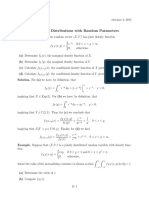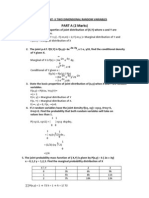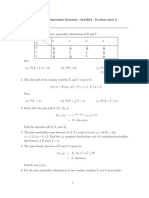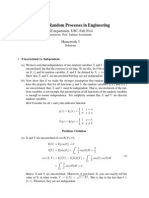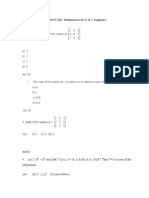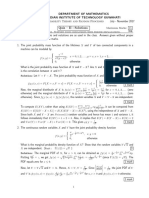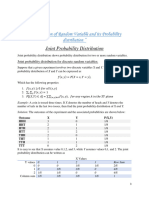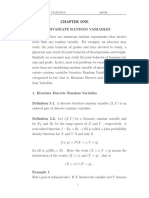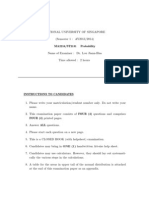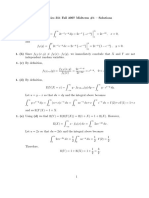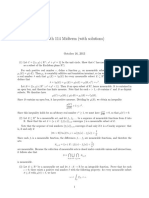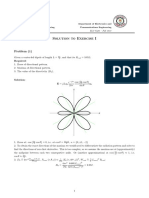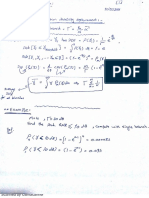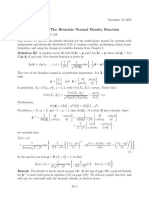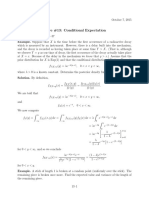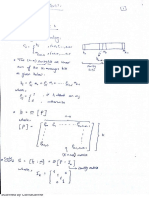Statistics 351 Midterm #1 October 6, 2008
This exam has 4 problems and 6 numbered pages.
You have 50 minutes to complete this exam. Please read all instructions carefully, and check
your answers. Show all work neatly and in order, and clearly indicate your final answers.
Answers must be justified whenever possible in order to earn full credit. Unless otherwise
specified, no credit will be given for unsupported answers, even if your final
answer is correct. Points will be deducted for incoherent, incorrect, and/or irrelevant
statements.
This exam is closed-book, except that one 8 12 11 double-sided page of handwritten notes is
permitted. No other aids are allowed.
You must answer all of the questions in the space provided. Note that blank space is NOT
an indication of a questions difficulty.
Name:
Instructor: Michael Kozdron
Problem
1
2
3
4
TOTAL:
Score
�1.
(24 points) Suppose that the random vector (X, Y )0 has joint density function
(
ey , if 0 < x < y < ,
fX,Y (x, y) =
0,
otherwise.
(a) Determine fX (x), the marginal density function of X, and E(X), the expected value
of X.
(b) Determine fY (y), the marginal density function of Y .
(c) Calculate fY |X=x (y), the conditional density function of Y given X = x.
(continued)
1
�(
ey , if 0 < x < y < ,
Recall that the joint density function of (X, Y )0 is fX,Y (x, y) =
0,
otherwise.
(d) Use the result of (c) to determine E(Y |X).
(e) Use the results of (a) and (d) to calculate E(Y ).
(f ) For a > 1, determine P {aX < Y }.
(continued)
2
�(
ey , if 0 < x < y < ,
Recall that the joint density function of (X, Y )0 is fX,Y (x, y) =
0,
otherwise.
(g) Determine the density function of the random variable X + Y .
Hint: Let U = X + Y , V = Y .
�2.
(10 points) Suppose that the random variable Y (p, 1/a) where p > 0 and a > 0 are
parameters so that the density function of Y is
fY (y) =
ap p1 ay
y e ,
(p)
y > 0.
Suppose further that X|Y = y (q, 1/y) where q > 0 is a parameter so that
fX|Y =y (x) =
y q q1 yx
x e ,
(q)
Determine fX (x), the density function of X.
x > 0.
�3.
(10 points) Suppose that Y1 , Y2 , . . . are independent and identically distributed random
variables with P {Y1 = 1} = p, P {Y1 = 1} = 1 p for some 0 < p < 1/2. Let S0 = 0 and
for n = 1, 2, . . ., let Sn = Y1 + + Yn denote their partial sums. Finally, for n = 0, 1, 2, . . .,
define
�S
�
1p n
.
Xn =
p
(a) Carefully verify that {Xn , n = 0, 1, 2, . . .} is a martingale.
(b) Compute E(Xn ), n = 0, 1, 2, . . ..
�4.
(6 points) The random vector (X, Y )0 is said to have a bilateral bivariate Pareto
distribution with parameters a, b, c, written (X, Y ) Pabb(a, b, c), if the joint density
function is given by
fX,Y (x, y) = c(c + 1)(b a)c (y x)c2
provided that c > 0 and < x < a < b < y < . If U = Y X and V = X, determine
fU,V (u, v), the joint density function of (U, V )0 .
















